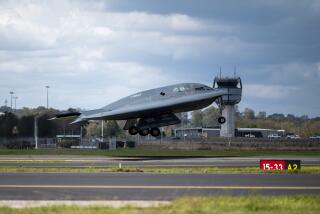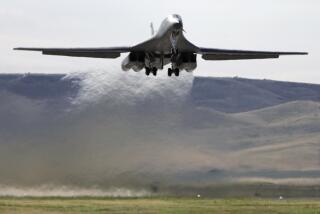B-2 stealth bombers get meticulous makeovers
- Share via
Hunched over, her eyes fixed downward, Tanya Hart inches across the vast wing of the B-2 stealth bomber one small step at a time, looking for any nicks or hairline scratches in the freshly repainted surface.
Even a tiny blemish could make the B-2 as visible on radar screens as a giant flying tin can. Hart, 50, is the last line of defense for what may be the world’s most expensive paint job.
“This isn’t a job where you can afford to mess up,” said Hart, a “surface technician” for Northrop Grumman Corp., which built the bombers and is now overhauling them.
The B-2 has been called one of the greatest achievements in military technology since the atom bomb. But keeping the massive, bat-winged plane from being detectable by radar is no easy task. It’s not cheap, either.
Overhauling a stealth bomber, which must be done every seven years, costs $60 million, on average, and usually takes a year.
The work is done at Northrop’s 45-acre complex in Palmdale, where hundreds of workers strip off the plane’s paint, panels, nuts and bolts, right down to the frame, before rebuilding it with new paint, parts and equipment.
The cost may be staggering, but the B-2 is no flying bus. Considered the world’s most technologically advanced aircraft, it can evade radar to slip behind enemy lines and knock out air defense systems and anti-aircraft missiles.
The 20 B-2s in service were built at a cost of $2.1 billion each, with many parts one-of-a-kind. Contributing to the high cost of an overhaul is the meticulous care that must be taken in restoring the bomber’s dark gray coating, known as “advanced high-frequency material,” which is the key to keeping it nearly invisible to radar.
Even so, the overhaul costs are a sore point with some military industry critics who have long called the B-2 a gold-plated boondoggle.
“It’s the ultimate hangar queen,” said Winslow T. Wheeler, an analyst at the Center for Defense Information, a Pentagon watchdog group.
The bomber, he said, is not useful for waging the kind of warfare being fought today against low-tech enemies. “It’s irrelevant in the wars in Iraq and Afghanistan,” he said.
The Air Force spent more than $800 million last year upgrading, maintaining and overhauling the stealth bomber fleet. For each hour it’s in the air, a bomber spends 50 to 60 hours on the ground undergoing maintenance.
The Pentagon, however, contends that it needs the bomber to extend U.S. military might across the globe.
In February, Defense Secretary Robert M. Gates said he did not expect the Air Force to develop and field a new bomber for nearly two decades, leaving the B-2 as the nation’s most advanced bomber for the foreseeable future.
The B-2 has seen action in both Iraq and Afghanistan, flying into heavily defended areas and clearing the way for other fighters and bombers by knocking out radar installations. Its debut came in 1999 in the Balkans, when several B-2s flew nonstop to Kosovo from their home base in Missouri to bomb bridges and a tank-making factory.
The task of keeping the B-2 flying has been a boon to Southern California and Century City-based Northrop. The plane has been a money-maker and a job creator for Northrop since the program started 30 years ago.
The Pentagon initially wanted 132 of the bombers. But it ultimately got funding to buy only 21, with the cost escalating to $2.1 billion per plane. The fleet now numbers 20 after one B-2 crashed in Guam in 2008.
The U.S. government lifted the veil on the super-secret B-2 stealth bomber program in 1988, exposing one of the largest weapons development efforts since the Manhattan Project. The Air Force and Northrop went to great lengths to conceal even the smallest detail.
Most suppliers had no idea they were making parts for the bomber. The government created dummy companies that ordered the parts, which were often picked up in the middle of the night by unmarked trucks.
The first B-2 rolled off the assembly line in 1988; the last in 1997. At its height, the program involved about 40,000 employees at aerospace facilities all over the country, including about 15,000 in the Southland. It continues to provide work to about 1,200 people, many of them at Northrop’s facilities in Palmdale where the B-2s were assembled.
The site, tucked behind barbed-wire fences, features five massive hangars protected by key card-accessed security doors. Although it’s a far cry from the cloak-and-dagger world of the 1980s, security is still a principal concern for Northrop and the government.
New hires have to wear yellow vests and cannot be left alone; even going to the bathroom requires an escort. Also, there are areas that only those with FBI-certified security clearance can access.
With so much taxpayer money at stake and outside oversight light — particularly because so much of the program is out of the public eye — the Air Force said it has 33 officers and civilian auditors on site to monitor the work in Palmdale.
It’s expensive to maintain because it is a technological marvel, said John Pike, director of Globalsecurity.org, a website for military policy research. “It’s a complicated plane, so it’s difficult to care for,” he said. “Most of the time there are more B-2s on the rack than on the ramp.”
The work is done in custom-built hangars that have special filtered vents for keeping the interior free of dust and maintaining a constant temperature year-round.
That’s because the B-2’s coat, which acts more like a skin than paint, is sensitive to heat and humidity.
The high-tech coating acts like a sponge that absorbs radar waves as they strike the plane. Even though the bomber has a wingspan nearly as long as a Boeing 747 jumbo jet, it looks the size of a tennis ball on a radar screen. The chemical composition of the coating is top secret.
Because of the special coating, when it comes time for an overhaul even the most mundane tasks become herculean. Technicians can’t simply scrape it off, it needs to be blasted off with wheat starch, an environmentally friendly material that looks like flour.
Workers then pop open the plane’s 100-plus access panels to replace worn wires and update electronic equipment. The original on-board radar systems and computer processors are swapped out with new hardware.
Other technicians scour the bomber for any nicks or dents that need to be patched up so the surface remains as smooth as glass for the new coating. Northrop declined to say how long it takes.
After the first coat is applied by robotic sprayers, technicians hand polish the surface to a required thickness, which cannot be off by more than a thousandth of an inch. Any variation reduces the skin’s ability to absorb radar waves. After several more coats, the surface takes on a hard rubber-like feel.
Exactly how long each process takes is top secret.
But the overall time it takes for the overhaul is a dramatic improvement from five years ago, when it took two years. Northrop said it was working to speed up the process to less than a year.
“This process is constantly being improved,” said Gregory L. Weed, director of Northrop’s depot and modifications center. “Now it takes a year. And we think we can do better than that.”
Although there is nothing else like the B-2, it’s still a plane from the 1980s built with 1980s technology, said Peter W. Singer, a senior fellow at the Brookings Institution think tank. Other countries have developed new ways to expose the B-2 on radar screens, so the Air Force has to upgrade the bomber in order to stay ahead.
“Technology doesn’t stand still; it’s always moving forward,” he said. “It may cost an arm and a leg, but you don’t want the B-2 to fall behind the times.”
More to Read
Inside the business of entertainment
The Wide Shot brings you news, analysis and insights on everything from streaming wars to production — and what it all means for the future.
You may occasionally receive promotional content from the Los Angeles Times.











